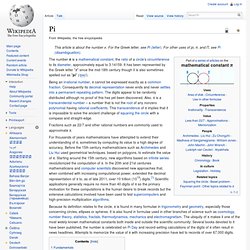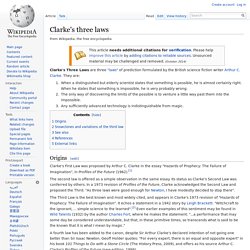

Pi and river length. The number π is a mathematical constant, the ratio of a circle's circumference to its diameter, approximately equal to 3.14159.

It has been represented by the Greek letter "π" since the mid-18th century though it is also sometimes spelled out as "pi" (/paɪ/). Being an irrational number, π cannot be expressed exactly as a common fraction. Consequently its decimal representation never ends and never settles into a permanent repeating pattern. The digits appear to be randomly distributed although no proof of this has yet been discovered. Tuned pipe. History[edit] Expansion chambers were invented and successfully manufactured by Limbach, a German engineer, in 1938, to economize fuel in two stroke engines.

Germany was running short of petrol, which was at that stage produced using coal and sewerage transformation. An unexpected bonus was that the two stroke engines using tuned exhausts produced far more power than if running with a normal silencer. After the end of the second world war, some time passed before the concept was re-developed by East German Walter Kaaden during the cold war. They first appeared in the west on Japanese motorcycles after East German motorcycle racer Ernst Degner defected to the west while racing for MZ in the 1961 Swedish Grand Prix.
How it works[edit] An approximation of an expansion chamber in operation. There are three main parts to the expansion cycle. 0.999... The repeating decimal continues with an infinite number of nines.

In mathematics, the repeating decimal 0.999... (sometimes written with more or fewer 9s before the final ellipsis, or as 0.9, 0.(9), or Every nonzero, terminating decimal has an equal twin representation with infinitely many trailing 9s (for example, 8.32 and 8.31999...). Category:Mysteries. "Mystery" is a loosely-defined term for either unsolved problems (especially unsolved crimes) and for the (alleged) "paranormal".

Please do not place articles here because a topic "has been described as" "a mystery". use one of the following categories: allegedly (according to widely known popular literature) "paranormal" mysteries (etc.) fictional or artificial mysteries unsolved problems problems with known solutions Subcategories This category has the following 5 subcategories, out of 5 total. Double bind. A double bind is an emotionally distressing dilemma in communication in which an individual (or group) receives two or more conflicting messages, in which one message negates the other.

This creates a situation in which a successful response to one message results in a failed response to the other (and vice versa), so that the person will automatically be wrong regardless of response. The double bind occurs when the person cannot confront the inherent dilemma, and therefore can neither resolve it nor opt out of the situation. Double bind theory was first described by Gregory Bateson and his colleagues in the 1950s.[1] Corundum. The name "corundum" is derived from Tamil word Kuruvindam or Sanskrit word Kuruvinda meaning ruby.[6] In addition to its hardness, corundum is unusual for its density of 4.02 g/cm3, which is very high for a transparent mineral composed of the low atomic mass elements aluminium and oxygen.[7] Geology and occurrence[edit] Corundum from Brazil, size about 2 cm × 3 cm (0.8 in × 1 in).

Synthetic corundum[edit] Banana equivalent dose. A banana equivalent dose (abbreviated BED) is a unit of radiation exposure, defined as the additional dose a person will absorb from eating one banana. The concept is based on the fact that bananas, like most organic materials, naturally contain a certain amount of radioactive isotopes—even in the absence of any contamination due to human nuclear endeavors. The banana equivalent dose was meant to express the severity of exposure to radiation, such as resulting from nuclear power, nuclear weapons or medical procedures, in terms that would make sense to most people.
History[edit] Clarke's three laws. Clarke's Three Laws are three "laws" of prediction formulated by the British science fiction writer Arthur C.

Clarke. They are: When a distinguished but elderly scientist states that something is possible, he is almost certainly right. When he states that something is impossible, he is very probably wrong.The only way of discovering the limits of the possible is to venture a little way past them into the impossible.Any sufficiently advanced technology is indistinguishable from magic. Origins[edit] Clarke's First Law was proposed by Arthur C. Siphonophorae. Description[edit] Like other hydrozoans, certain siphonophores can emit light.

Spring Heeled Jack. There are many theories about the nature and identity of Spring-heeled Jack.

This urban legend was very popular in its time, due to the tales of his bizarre appearance and ability to make extraordinary leaps, to the point that he became the topic of several works of fiction. Spring-heeled Jack was described by people who claimed to have seen him as having a terrifying and frightful appearance, with diabolical physiognomy, clawed hands, and eyes that "resembled red balls of fire".
One report claimed that, beneath a black cloak, he wore a helmet and a tight-fitting white garment like an oilskin. Many stories also mention a "Devil-like" aspect. Others said he was tall and thin, with the appearance of a gentleman. History.